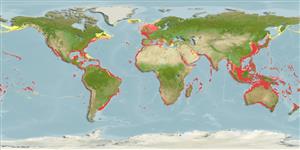Common names from other countries
Environment: milieu / climate zone / depth range / distribution range
экология
пелагический; пределы глубины 0 - 200 m (Ref. 83938). Tropical; 50°N - 42°S, 180°W - 180°E (Ref. 275)
Circumglobal in tropical and warm temperate seas.
Length at first maturity / Size / Вес / Возраст
Maturity: Lm ? range ? - ? cm Max length : 72.6 cm TL (female)
Maximum total length: male, 1.5 to 2.0 cm. Maximum length of shell, 30 cm in females; males are of dwarf size, only 1.5 to 2 cm in total length (Ref. 275). Maximum total length 72.6 cm, and mantle length 14.14 cm for females (122434). Epipelagic (Ref. 83938). Females use the shell to trap air, gathered at the sea surface, to attain neutral bouyancy (Ref. 96968). Few shells found washed up on beaches (Ref. 88739).
Life cycle and mating behavior
половая зрелость | размножение | нерест | икра | Fecundity | личинки
On contact with the female, it is presumed that the male autotomizes the hectocotylus. Multiple hectocotyli can persist in shells and mantle cavities of females for extended periods. Eggs of up to five different developmental stages may be present within a single shell (Ref. 96968). Females inhabit the shell of Nautilus for egg deposition and brooding (Ref. 98241).
Основная ссылка
ссылки | координатор | соавторы
Roper, C.F.E., M.J. Sweeney and C.E. Nauen. 1984. (Ref. 275)
Статус Красного Списка МСОП (Ref. 130435)
Статус СИТЕС (Ref. 108899)
Not Evaluated
Not Evaluated
Использование человеком
рыболовство: коммерческий
| FishSource |
инструменты
дополнительная информация
Возраст/РазмерыростЗависимость между длиной и массой телаЗависимость между длинамиморфологияличинкичисленность
ресурсы в Интернет
Estimates based on models
Preferred temperature
(Ref.
115969): 13.6 - 27.8, mean 23.8 (based on 1594 cells).
Уязвимость
Low vulnerability (10 of 100).
Категория цены
Unknown.
